The best time for beginners to start fell walking is from late March to early October, with late April to early June and September to early October being particularly excellent. These months offer pleasant weather, fewer crowds, and full operational amenities. May and June provide mild temperatures and vibrant landscapes, while September showcases stunning autumn foliage. To avoid peak foot traffic, consider mid-week hikes or choosing less popular routes. Essential gear includes layered clothing, navigation tools, and quality footwear. For further insights on prime planning and enhancing your walking experience, there are additional considerations worth exploring.
Key Takeaways
- Late March to early October offers ideal weather for beginners, with mild temperatures and extended daylight.
- May and June are recommended for minimal rainfall and vibrant landscapes, enhancing the walking experience.
- September and early October provide pleasant weather and quieter trails, avoiding school holiday crowds.
- Facilities like cafes and campsites are fully operational from Easter to October, perfect for accommodating beginners.
- Early or late walks offer excellent light for photography and avoid peak trail traffic.
Weather Considerations
When considering the ideal time to begin fell walking, weather plays a critical role in determining a positive experience for beginners. In the UK, the climate is notoriously unpredictable, yet the period from late March to early October generally promises warmer, drier conditions, essential for comfortable trail conditions.
The South-West Coast Path, for instance, reported only two rainy days over 53 days, underscoring the potential for favorable weather patterns during this timeframe.
May and June are particularly recommended for novice fell walkers. These months typically bring pleasant temperatures and minimal rainfall, creating ideal trail conditions for those just starting out.
Additionally, the reduced visitor numbers enhance the serene experience of nature, allowing beginners to focus on enjoying the walk rather than steering through crowded paths.
It's also significant that many essential amenities such as cafes, campsites, and B&Bs operate seasonally, mainly from Easter through October.
Planning hikes during this period guarantees the availability of comfort and convenience services. Understanding these weather considerations can greatly enhance the fell walking experience, making it safer and more enjoyable for those new to this outdoor activity.
Avoiding Crowds
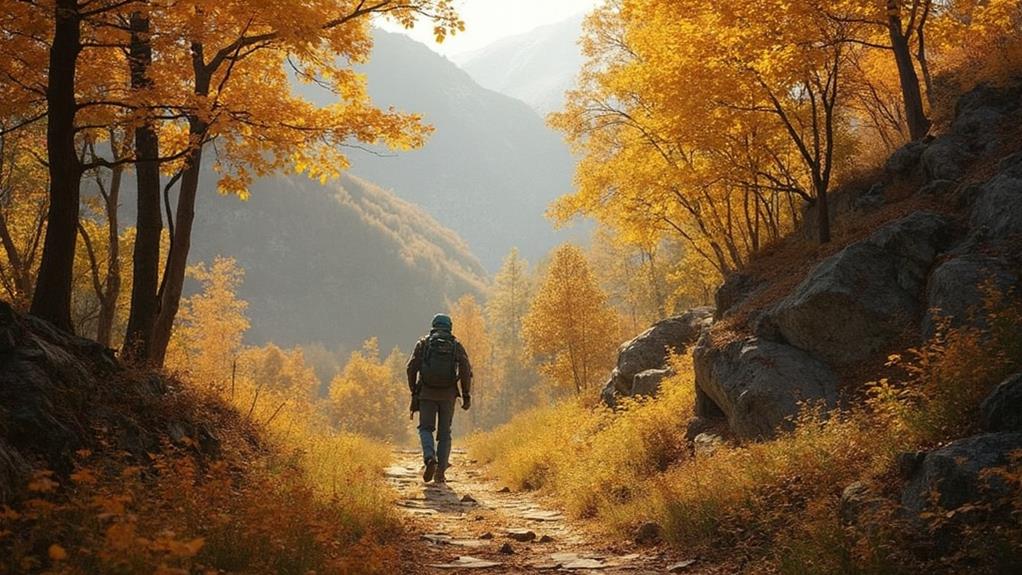
Understanding weather considerations is only part of planning an enjoyable fell walking experience; equally important is the strategy for avoiding crowds. Effective crowd management starts with choosing the right time. Off-peak months such as May, June, September, and early October offer the dual benefit of pleasant weather and fewer walkers, ensuring a more tranquil journey. Avoiding peak periods like summer, Easter, and half-term holidays considerably reduces the likelihood of encountering crowded paths.
To further enhance the experience, consider mid-week hikes along coastal paths, as these tend to be less frequented by walkers, particularly on weekdays. Early morning or late afternoon walks are another effective way to bypass peak foot traffic, allowing for a more serene exploration of the fells. Practicing trail etiquette, such as yielding to faster walkers and minimizing noise, also contributes to a more harmonious environment for all.
| Strategy | Benefits | Ideal Timing |
|---|---|---|
| Off-Peak Months | Quieter, less crowded | May, June, Sept, early Oct |
| Mid-Week Hikes | Less foot traffic | Weekdays |
| Early/Late Walks | Peaceful exploration | Early morning, late afternoon |
Choosing less popular routes can further enhance the experience, offering a quieter atmosphere and fewer distractions from fellow walkers.
Facility Availability
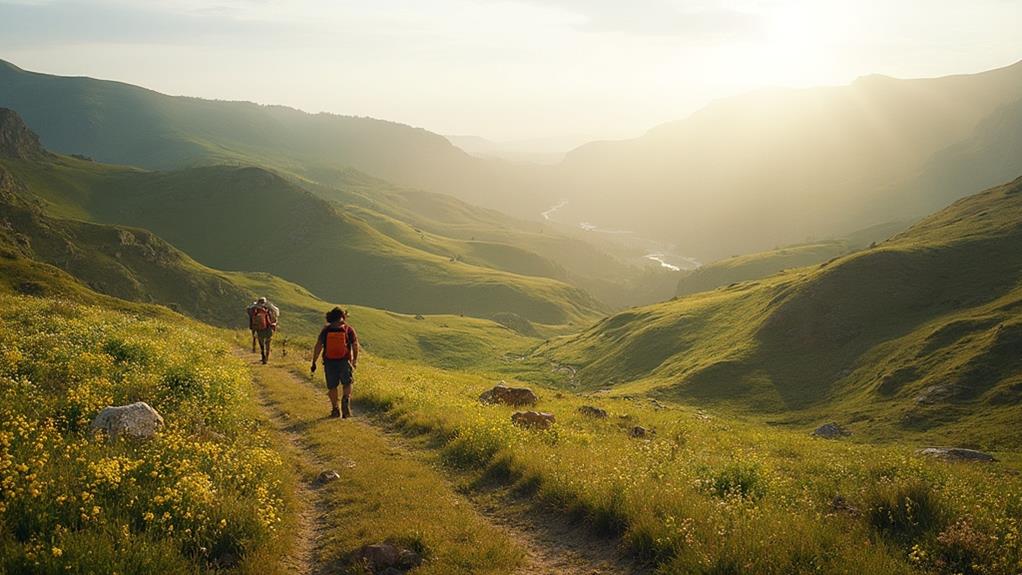
Facility availability plays an important role in planning successful fell walking trips, particularly for beginners.
The majority of cafes, campsites, and bed and breakfasts catering to fell walkers operate seasonally, typically from Easter to October. This makes it vital to plan hikes during these months.
To guarantee a comfortable and convenient experience, researching and scheduling trips when these amenities are open is highly advisable.
Seasonal Operating Months
For those starting on their first fell walking adventure, timing can make all the difference. Understanding the seasonal impact on facility availability is essential for a successful experience.
In popular fell walking areas, many cafes, campsites, and B&Bs operate seasonally, typically from Easter to October. This period coincides with the peak walking season, offering the most favorable conditions for beginners. Important beginner tips include planning your trip during these months to guarantee access to a variety of open amenities, which can greatly enhance your walking experience with available refreshments and shelter.
During the winter months, many facilities close, which can lead to potential disappointment for walkers seeking respite after long treks. For novices, the late spring and early summer months, particularly May and June, represent an ideal starting point. During this time, facilities are fully operational, and the weather tends to be more stable, providing a safer and more enjoyable introduction to fell walking.
Given the popularity of these months, especially around school and bank holidays, it is advisable to book accommodations well in advance. This guarantees availability and avoids the inconvenience of fully booked facilities during your planned adventure.
Planning for Open Amenities
Planning your fell walking adventure involves more than just choosing the right season; it requires careful consideration of facility availability along your route. Many popular walking areas offer amenities like cafes, campsites, and B&Bs seasonally, typically from Easter to October. Trail access during this period guarantees that essential services are available, enhancing the overall experience for beginners. However, facilities often close in the winter months, necessitating thorough local research to avoid disappointment after a long day on the trails.
| Season | Amenities Availability | Crowds |
|---|---|---|
| Easter-October | High | Moderate-High |
| Winter | Limited | Low |
| Summer | High | High |
| Off-Peak | Open | Low-Moderate |
Booking accommodations in advance during peak times, such as summer and school holidays, is advisable as many establishments fill up quickly. For a more pleasant experience, consider scheduling your hikes during off-peak periods when amenities remain open, yet crowds are thinner. This approach not only secures access to food and shelter but also reduces the likelihood of crowded trails. Always verify the opening times of specific facilities along your chosen route to ascertain a seamless and enjoyable fell walking experience.
Scenic Beauty
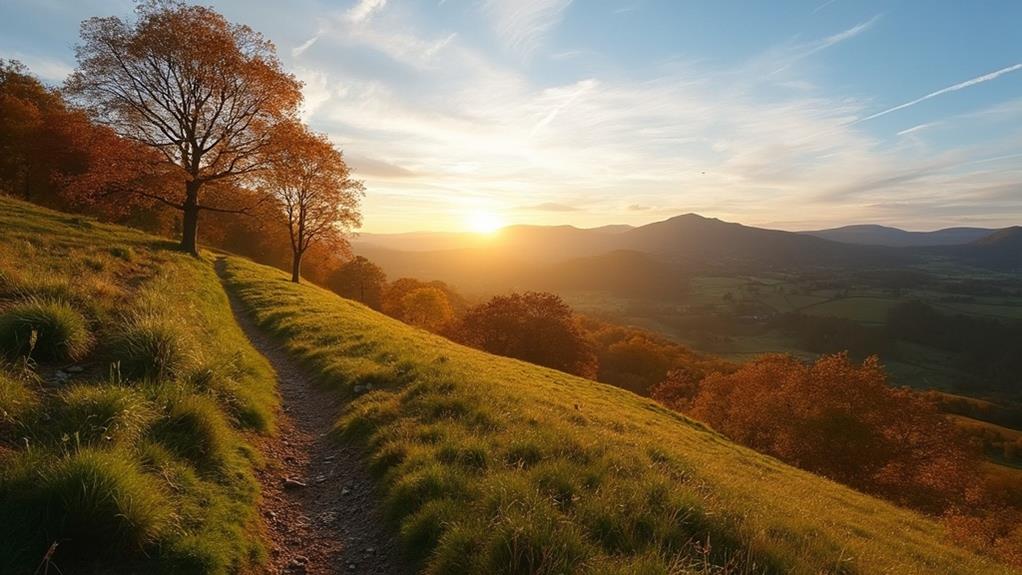
Invariably, the allure of fell walking is profoundly enhanced by the scenic beauty that each season uniquely offers. Late spring, specifically May and June, marks a period where vibrant landscapes come alive with the bloom of wildflowers and lush greenery, offering extraordinary photographic opportunities.
This period transforms the fells into a verdant canvas, inviting both novice and seasoned walkers to capture its natural splendor.
As the year progresses into autumn, the scenery shifts dramatically with the foliage adopting hues of amber, gold, and crimson. September through early October provides breathtaking vistas as these colors contrast vividly against the rugged terrain.
This seasonal palette not only enriches the visual experience but also presents ample opportunities for capturing the essence of the fells' changing moods.
Winter, though challenging for beginners, offers unparalleled scenic beauty, with snow-capped peaks and frost-tinged valleys creating an ethereal landscape.
For those who venture out, these months promise unique photographic opportunities, revealing the fells in a stark, peaceful beauty.
Ideal viewing times during any season are early morning or late afternoon, when the interplay of light and shadow accentuates the terrain's natural textures, enhancing the overall experience.
Ideal Walking Months
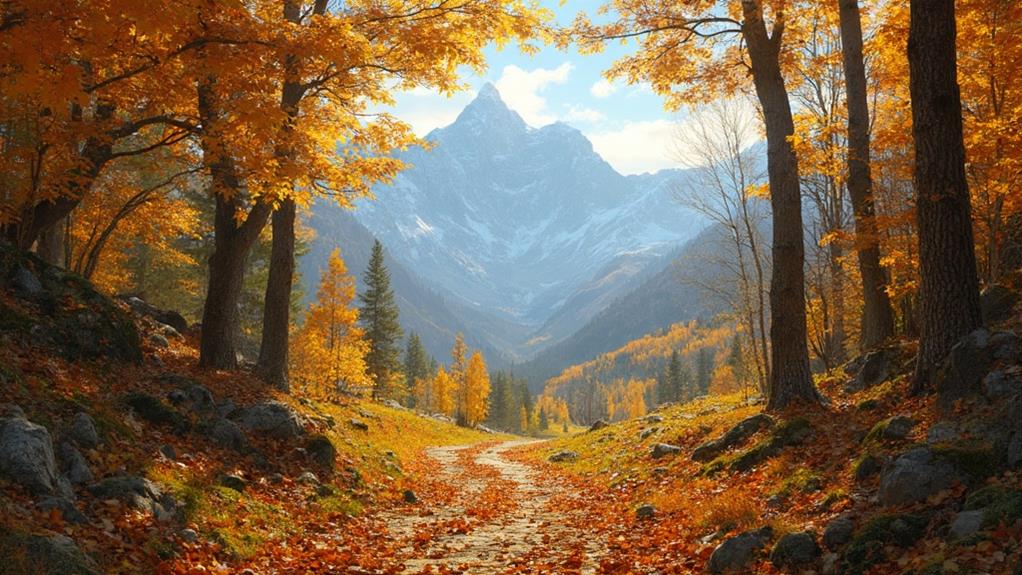
For beginners venturing into fell walking, selecting the right months is essential for an ideal experience.
Late April to early June and September to early October are recommended periods, offering milder weather conditions and vibrant natural scenery, with trails less congested than during peak summer.
During these months, the availability of seasonal amenities and the flourishing flora not only enhance safety and comfort but also enrich the visual appeal of the landscapes.
Optimal Weather Conditions
Typically, the ideal time for beginners to commence fell walking is between late March and early October, when the weather conditions are most favorable. During these months, optimal temperature ranges and reduced precipitation create an environment conducive to safe and enjoyable walking experiences.
May and June stand out as particularly advantageous due to their mild temperatures and extended daylight hours, which enhance visibility and reduce the risk of fatigue. It is essential for beginners to heed safety tips, such as dressing in layers and carrying weather-appropriate gear, to adapt to sudden changes in conditions.
Late April and early July also offer excellent walking scenarios, provided they do not overlap with school holidays, which can lead to increased trail traffic.
As the summer season progresses into September and early October, the weather remains pleasant; additionally, the post-summer lull results in quieter trails, offering a more tranquil experience.
However, it is vital for beginners to regularly check local weather forecasts, as conditions in mountainous areas can shift rapidly, even during prime months. This vigilance guarantees preparedness for unexpected weather changes, enhancing overall safety and enjoyment for those new to fell walking.
Seasonal Trail Availability
When considering the ideal walking months for beginners, understanding seasonal trail availability is essential. Late March to early June is a prime period for those newly starting on fell walking. During this time, trails typically offer greater accessibility due to warmer and drier conditions, contributing to a more enjoyable and less challenging experience.
The months of May and June are especially advantageous for beginners. Not only do they provide extended daylight hours, which enhance safety and allow for leisurely exploration, but they also coincide with vibrant spring landscapes that enrich the walking experience.
Autumn, particularly from September to early October, provides another window of opportunity for beginners. During this season, milder temperatures and reduced trail congestion create an ideal environment for novice walkers to hone their skills without the pressure of large crowds.
However, it is prudent for beginners to avoid peak holiday periods such as summer and Easter, when trail accessibility can be compromised due to high foot traffic, detracting from the learning experience.
Flora and Scenery Changes
Understanding the changes in flora and scenery throughout the year enhances the fell walking experience, particularly for beginners seeking the most visually rewarding times to explore. Spring, spanning from March to June, is a feast for the senses with its vibrant spring blooms and lush greenery, as nature awakens from winter's slumber. This period offers an invigorating atmosphere, perfect for novice walkers seeking picturesque trails adorned with wildflowers.
The summer months of July and August, with extended daylight and warm temperatures, allow for uninterrupted exploration of the expansive landscapes. This is a time when the rich flora of the fells is in full display, offering a splendid backdrop for outdoor enthusiasts.
As autumn arrives from September to November, the fells are transformed by the stunning autumn colors, where golden and red hues paint the trails with breathtaking beauty. Early autumn, particularly September, is ideal for beginners due to its mild weather and vibrant scenery.
| Season | Notable Features |
|---|---|
| Spring | Spring blooms, greenery |
| Summer | Long days, warm weather |
| Autumn | Autumn colors, mild weather |
| Winter | Snowy peaks, frosty views |
Planning Your Route
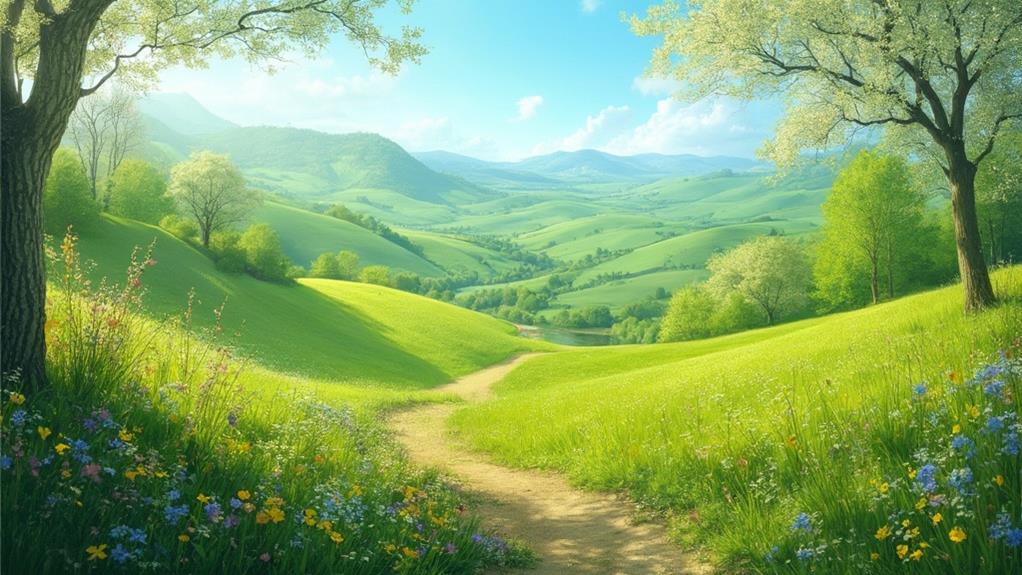
Considering the diverse challenges of fell walking, planning your route is a crucial step that demands careful attention to both safety and enjoyment. A thorough terrain assessment enables walkers to understand the difficulty level of the landscape and select paths that align with their skill level.
Opting for well-known routes not only guarantees a safer experience but also increases the likelihood of timely assistance if required. Equally important is landmark identification; familiarizing oneself with key reference points on a detailed map aids navigation and reduces the risk of getting lost.
Analyzing various route options before initiating your journey allows flexibility to adapt to unforeseen weather changes or fatigue.
Beginners should incorporate alternative shorter routes into their plans, guaranteeing they can adjust their trek to maintain enjoyment and avoid overexertion when conditions become challenging. This strategic planning promotes a more enjoyable experience and safeguards personal well-being.
Essential Gear and Clothing
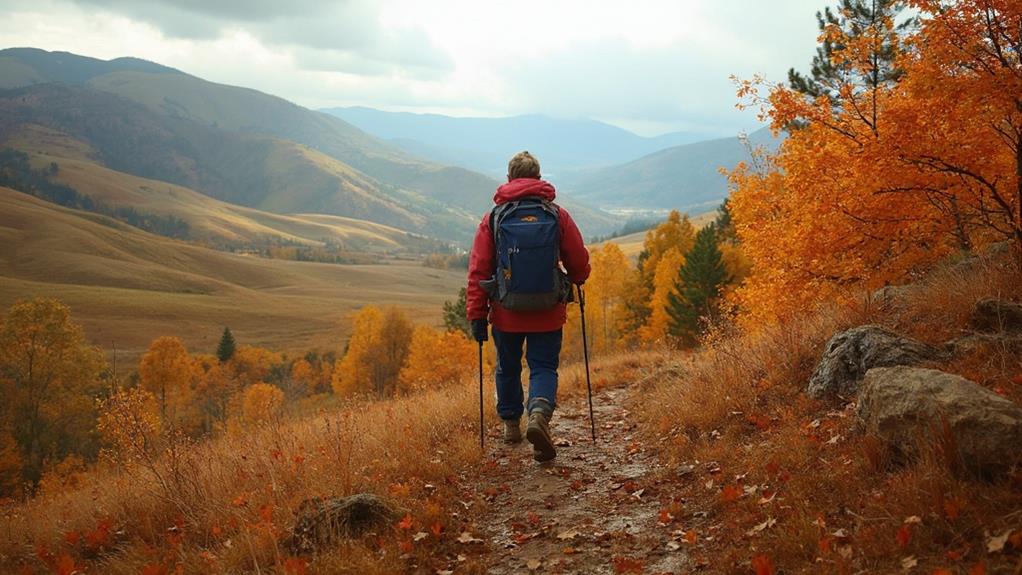
Starting on a fell walking adventure requires more than just enthusiasm; it demands the right gear and clothing to guarantee both safety and comfort. A well-considered shoe selection is essential for maneuvering the varied terrain typically encountered in fell walking. Quality trail running shoes with cushioning and a moderate heel-to-toe drop of 8-10mm offer the ideal balance of comfort and performance, ensuring stability and reducing the risk of injury on uneven paths.
Equally important is the strategic use of clothing layers to adapt to the unpredictable weather often experienced during fell walks. Begin with moisture-wicking base layers to keep perspiration at bay, followed by insulating mid-layers for warmth. A waterproof and windproof outer layer is necessary for protection against the elements, providing both comfort and safety in adverse conditions.
In addition to footwear and clothing, essential gear such as a lightweight backpack and a first aid kit should not be overlooked. Navigation tools like a map or GPS device are critical for trail safety, while accessories including a hat, gloves, and trekking poles can greatly enhance stability and comfort.
Social Walking Opportunities
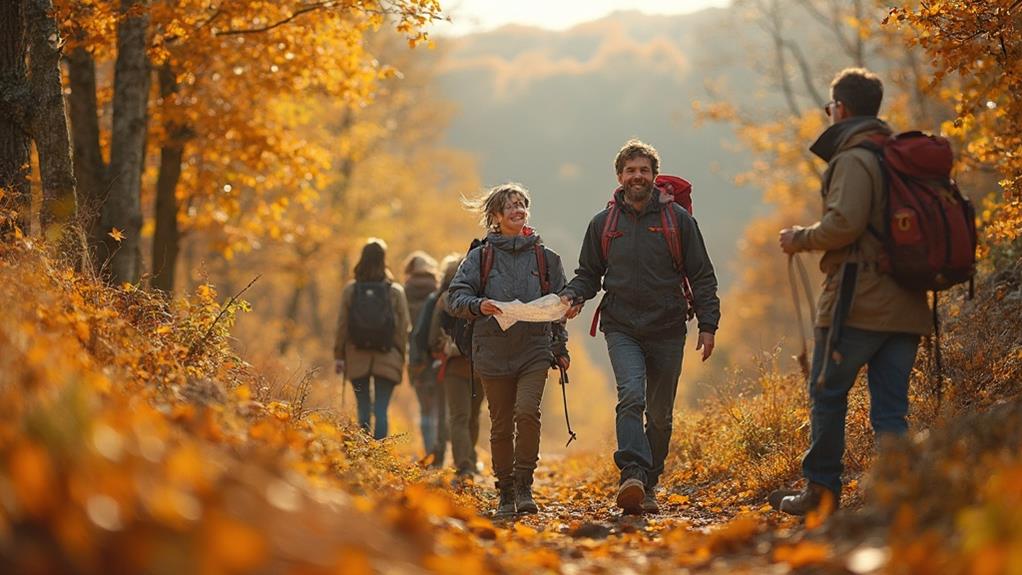
Equipped with the right gear and clothing, beginners are well-prepared to enhance their fell walking experience through social walking opportunities.
Engaging with local walking groups offers a gateway to community engagement, where novices can benefit from the collective wisdom of seasoned walkers. These groups not only provide logistical support but also foster a sense of camaraderie and shared learning.
Organizations like The Ramblers are instrumental in structuring these experiences, offering guided walks tailored for various skill levels, thereby building confidence among beginners.
Community engagement through walking groups is pivotal for new walkers. Here's why:
- Learning Experiences: Beginners gain valuable insights from experienced walkers, discovering new trails and techniques that improve their skills and enjoyment.
- Social Connections: Joining these groups helps forge friendships with fellow enthusiasts, enhancing the outdoor experience through shared interests and goals.
- Motivation and Accountability: Social events encourage regular participation, helping maintain enthusiasm and commitment to a walking schedule.
- Access to Resources: Local libraries and tourist centers often provide information on upcoming events, making it easier for beginners to find and join suitable walking opportunities.
Frequently Asked Questions
How to Get Fit for Hill Walking for Beginners?
To develop a fitness routine for hill walking, start with daily walks, gradually increasing intensity and elevation. Incorporate interval training and use appropriate walking gear, including a day pack, to condition your body for the demands of fell walking.
How to Start Fell Walking?
To begin fell walking, prioritize gear selection by investing in quality footwear and essential navigation tools. Adhere to safety tips such as starting with well-marked trails, mastering map reading, and joining local groups for guidance and support.
What Is the Best Time for Outdoor Walk?
The best time for outdoor walking involves seasonal advantages and weather considerations. Late spring and early summer offer warm, dry conditions, while early autumn provides stable weather. Both are perfect for enjoying nature without encountering harsh environments.
What Is the Best Time to Go for a Walk?
The best time to go for a walk involves considering weather conditions and seasonal advantages. Opt for late spring or early autumn, when temperatures are mild, precipitation is minimal, and natural scenery offers its most vibrant displays.
Conclusion
The ideal time for beginners to start on fell walking is influenced by various factors, including favorable weather conditions, reduced crowds, and enhanced facility availability. The scenic beauty of the landscape is at its peak during certain months, offering a visually rewarding experience. Planning an appropriate route, equipped with essential gear and clothing, guarantees safety and comfort. Additionally, engaging in social walking opportunities can enhance the experience, providing camaraderie and shared knowledge among fellow walkers.